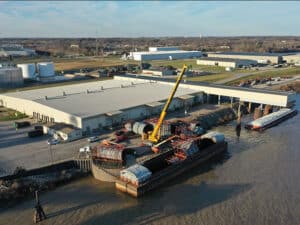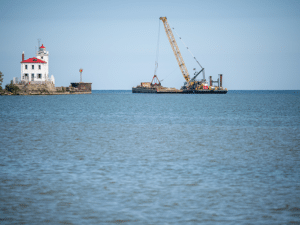
New underwater sill will counter salt water creep up Mississippi River
Written by Marine Log Staff
The New Orleans Engineer District is to construct an underwater sill across the bed of the Mississippi River channel to prevent further upriver progression of salt water from the Gulf of Mexico.
“We have coordinated closely with our state and local partners as well as incorporated lessons learned from last year’s low water season,” said Col. Cullen Jones, commander of the USACE New Orleans District. “We are confident we will see the same level of success with this saltwater barrier that we achieved with previous efforts.”
The Mississippi River’s volume of water has fallen to a level that allows salt water from the Gulf of Mexico to intrude upstream. The intrusion of salt water into the river is a naturally occurring periodic condition because the bottom of the riverbed between Natchez, MS, and the Gulf of Mexico is below sea level. Denser salt water moves upriver along the bottom of the river beneath the less dense fresh water flowing downstream. Under normal conditions, the downstream flow of the river prevents significant upriver progression of the salt water. However, in times of extreme low volume water flow, unimpeded salt water can travel upriver and threaten municipal drinking water and industrial water supplies.
To arrest the upriver movement of the salt water and reduce the risk to freshwater intakes, USACE will construct an underwater barrier sill near Myrtle Grove, La., using sediment dredged from an area designated for this purpose. The sill will take approximately two weeks to complete but will demonstrate benefits in advance of completion. The sill has been constructed on four previous occasions in 1988, 1999, 2012 and again in 2022.
The Corps constructed a similar underwater sill in October 2022 at river mile 64, near Myrtle Grove, La., to arrest the progression of salt water intrusion during that year’s low water season. That particular sill eroded away when fresh water from the Mississippi River pushed the saltwater wedge back down the river to the Gulf of Mexico.




